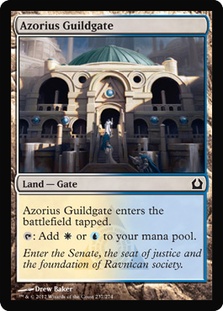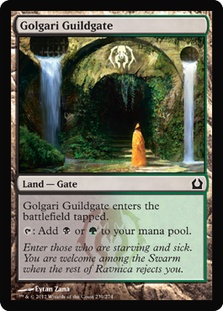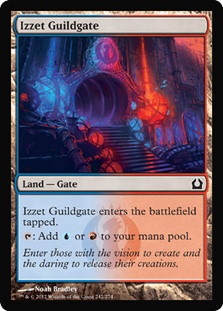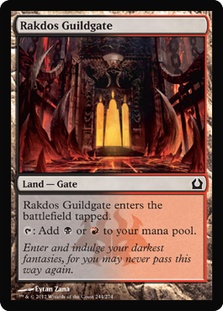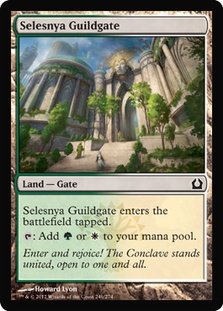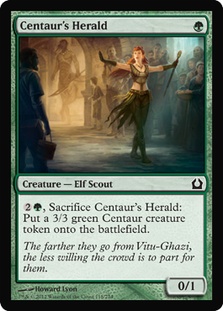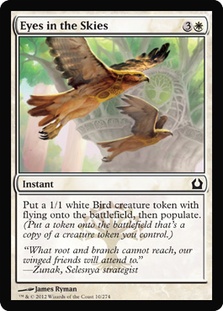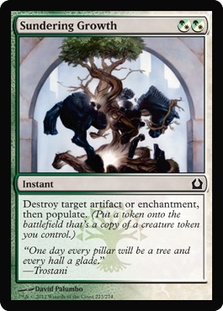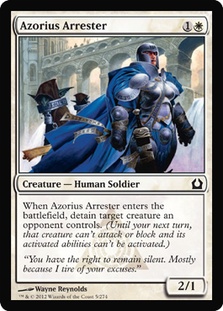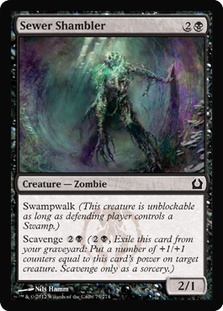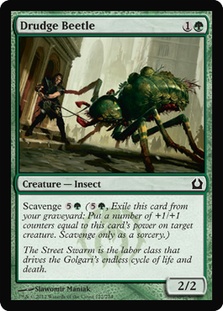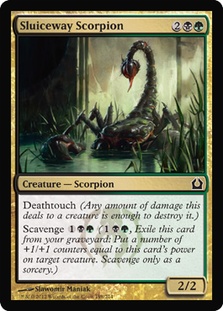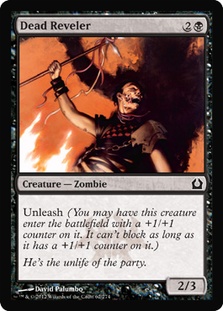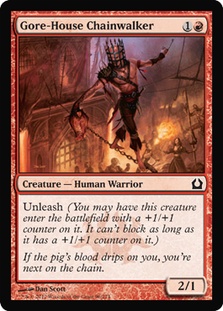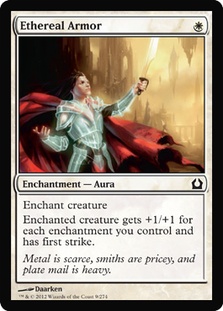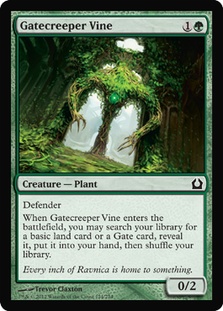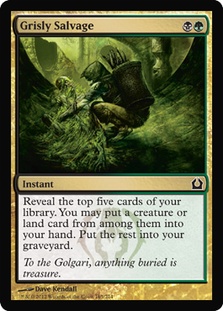Return to Ravnica is upon us, and that means the Gates are here. When Golgari Guildgate was spoiled, I was in the middle of the woods and my phone was off. When I turned it back on, the chirps from my phone echoed loudly in the valley.
The release of the Gates (five in Return to Ravnica and five all but confirmed in Gatecrash) are some of the most important additions to Pauper. Ever. The Gates force us to reevaluate the entire Pauper card pool and reexamine every multicolor card from the past. They also will impact the way decks are constructed, particularly mana bases.
In order to understand what these lands mean for the future, we must first look to the present. Pauper is largely a monochromatic format. The best two color decks are Izzet (U/R) and Dimir (U/B) flavors of Cloudpost that run cheap removal to reach the mid and late game (where the decks will have access to both colors they need) and U/B Ninja variants that operate on a similar principle and use persistent card advantage creatures to make up for time spent developing a mana base.
Affinity and Storm both utilize multiple colors but have highly specialized mana bases that are unique to their decks and help fuel the broken mechanics. Beatdown is popular, but aside from Affinity, aggro decks rely on one land type. The best aggressive strategies—Goblins, Infect, Stompy, Delver, and White Weenie—are all one color because they have to be. There are no lands that enable these decks to have a play on turn 1 and produce multiple colors (this is something the Gates will not change).
Slower decks can make use of Terramorphic Expanse and Evolving Wilds to fix their mana without losing the proverbial beat. These decks can also employ the bouncelands/Karoos from the first Ravnica Block (a la Izzet Boilerworks) to milk extra mana from their lands while generating positive card economy. If the land returned by a Karoo was tapped for mana, then it acts as an additional draw. The Karoo replaces one land drop with two mana, at the cost of the land, which can be played next turn for a small net loss of tempo (but at the profit of a card). This factor helps make Karoos excellent includes for control decks.
The major drawback of Karoos is that they require another land to be in play and do nothing until turn 3 at the earliest. While aggressive decks have run these cards in the past (Ravnica era Boros lists ran some number of Boros Garrisons as a way to eke out more mana from a reduced land count), these decks had access to “true” dual lands that could enter the battlefield untapped. A pilot of such a deck could play a strong two-drop on turn 3, follow it up with a Karoo, and set up a very strong turn 4. Without the possibility of a strong turn 1 and 2 as well as access to multiple colors to set this up, Karoos are largely dead for Pauper aggro.
Being the beatdown in Pauper can be seen as fighting an uphill battle. Creatures, especially at common, have been underpowered for a large portion of Magic’s almost two decades of history. It is only recently that creatures have been good and sometimes great (compare Ironclaw Orcs to Gore-House Chainwalker, for example). Creatures also have to start their assault on turn 1, otherwise they risk falling too far behind control and combo. Aside from Infect, Pauper aggro decks have to run at least eight one-drops (and Infect sometimes cheats by running Lotus Petal to power out two-drops on the first turn).
Control decks have multiple ways to answer turn 1 aggressors, from removal to Glimmerpost to blockers. Going into multiple colors increases the risk of missing the earliest drop, increasing the slope of the hill. In order to be a Gate and Karoo aggro deck, our hypothetical would need one-drops of each color (or lean heavily on Vault Skirge and Flayer Husk) and have to be guaranteed to draw a matching land in 100% of its opening hands to pull the same trick as Ravnica era Boros.
The odds are not in favor of this occurring.
Pauper aggro, as it currently exists, will remain largely unchanged. While the mana situation is much improved, it’s still hostile to beatdown. That being said, attacking will be fine, as these decks will keep getting cards with each new release. The Gates are not a panacea for two-color aggro, but they will help to enable the oft-sought Pauper midrange decks.
One complaint that is popular, at least from the less Spike-ish members of the PDCMagic.com message boards, is that Pauper has no room for midrange decks. While this contingent largely ignores White Weenie as midrange aggro and Mono-Black as midrange control, their argument is actually that the format is too fast to play multiple colors and succeed. Well, good news, everyone! The Gates are going to help ease the pain of being gold in Pauper. Once Gatecrash is released, every color pair will have a Gate, a Karoo, and access to three fetchlands (including the Panoramas from Shards of Alara). The mana will be, in a word, better. The cost for this increase in mana quality will be high, often in the form of a turn of board development or more.
In order to offset this, the turn 2 play of a Gate deck will have to be exceptionally strong. Wall of Roots and Overgrown Battlement both come to mind, but what’s the point of having dual lands if you’re just going to be making green mana? Perhaps the best option from Magic’s past is Putrid Leech. A fantastic creature that has not found a permanent home, Putrid Leech acts as a deterrent to attacking while being fully capable of bringing the beats. Suiting one up with Rancor seems a scary bit of wishful thinking. A Gate deck with Leech would likely feature disruption alongside Rancor and would play nicely with a staple of Rat decks: Unearth.
Creatures (24)
Lands (22)
Spells (14)

Another big winner because of the Gates is not a turn 2 drop but rather a turn 3 play that’s also from Alara block: Blightning. Another strong card without a home, Rakdos Guildgate helps enable a strategy where casting Blightning on turn 3 is a very real possibility, especially when backed up by the strong early game of the Cult of Rakdos. Here, a strong two-drop isn’t as important (although this guild certainly has those) as these colors have multiple two-power one-drops and some new additions from Return to Ravnica in Rakdos Shred-Freak and Gore-House Chainwalker.
Creatures (21)
- 3 Keldon Marauders
- 4 Vampire Lacerator
- 4 Vault Skirge
- 4 Rakdos Shred-Freak
- 2 Dead Reveler
- 4 Gore-House Chainwalker
Lands (22)
Spells (17)

The Gates are absolute game changers and are the most important cards for Pauper that have been printed since the format was sanctioned. Pick yours up if you want to play Pauper.
And now for the rest of the set. Rather than examine all the cards individually, I’ll take a look at the different guild mechanics and then the outliers.
Populate is interesting to evaluate. The majority of tokens in Pauper are of the 1/1 variety. If Centaur’s Herald catches on, look for cheaper populate spells like Eyes in the Skies and Sundering Growth to see play. The Herald plays nicely with Rancor while also providing a sizable body late—something that might work well in Stompy builds (independent of populate). The other best tokens seem to be those provided by Penumbra Bobcat and Penumbra Spider, but the other populate spells are currently too expensive to see serious play in Classic Pauper.
Overload is exciting, and two of the spells are likely to see play. Electrickery is as close to a game changer as we’re going to get. This card is a fine maindeck include that does work against White Weenie, Delver, and Stompy while also totally hosing Empty the Warrens. The inability to hit players is annoying, but this is the best sweeper Pauper has gotten in a long time. On the other side of the coin, Mizzium Skin fights all of Empty the Warrens’ worst enemies, negating just about every sweeper that can be brought in to fight the token monster.
Detain‘s strength depends on your opponent’s deck. Currently, not many decks employ creatures that like to block or make great use of activated abilities. Azorius Arrester is the card most likely to see play from this crop, as it is on curve and acts as a semi Falter. That being said, White Weenie has much better options.
Scavenge is at its best with hexproof creatures, but also when the scavenge cost is in line with the casting cost of the creature. Sewer Shambler is on point but a bit slow. It provides an evasive beater (which might be relevant in black mirrors), but the scavenge cost follows in suit with casting cost. Drudge Beetle is the opposite; it’s a solid two-drop, but the deck that wants its effect most (Stompy) rarely gets to six mana. If it does, chances are it’s already losing. Sluiceway Scorpion is another great example of a card that fits the curve, but the initial cost of four might be too much for Pauper.
Unleash looks to be the best mechanic for Pauper. As mentioned, very few decks want to block, so getting extra power while attacking seems good. Dead Reveler and Gore-House Chainwalker provide larger than normal bodies at their spots on the curve and can apply serious pressure.
Other cards of note:
Ethereal Armor has a home in Selesnya Auras, already a fringe deck. Including another cheap incentive could push this deck from the fringes to a player. Rancor is good enough to run on its own, and this is +2/+2 with one Rancor on the board. With cards like Aura Gnarlid, I would expect such a deck to be patrolling the Tournament Practice room shortly after Return to Ravnica’s release on Magic Online.
Gatecreeper Vine will be a real factor if a three-, four-, or five-color control deck ever becomes a reality.
Centaur Healer is a fine on curve beater for any Selesnya deck with the added bonus of boosting life total. If the colors of the Conclave ever decide to be the beatdown, this will be a strong option.
Goblin Electromancer certainly seems like a strong Storm enabler. Unlike the Familiars, it does not reduce the cost of Cloud of Faeries, which is a huge crimp in Temporal Storm’s plan. Better combo minds than mine will break this for sure, so pick yours up as soon as possible.
Grisly Salvage will find a home in Tortured Existence decks, helping to find the one creature you need (or need to get rid of).
My official “pick up” list for Return to Ravnica is:
4 of every Guildgate
3 Mizzium Skin
4 Dead Reveler
4 Electrickery
4 Gore-House Chainwalker
4 Centaur’s Herald
4 Gatecreeper Vine
4 Centaur Healer
4 Goblin Electromancer
4 Grisly Salvage
4 Rakdos Shred-Freak
4 Sundering Growth
Keep slingin’ commons-
-Alex
SpikeBoyM on Magic Online
The Colors of Pauper:

